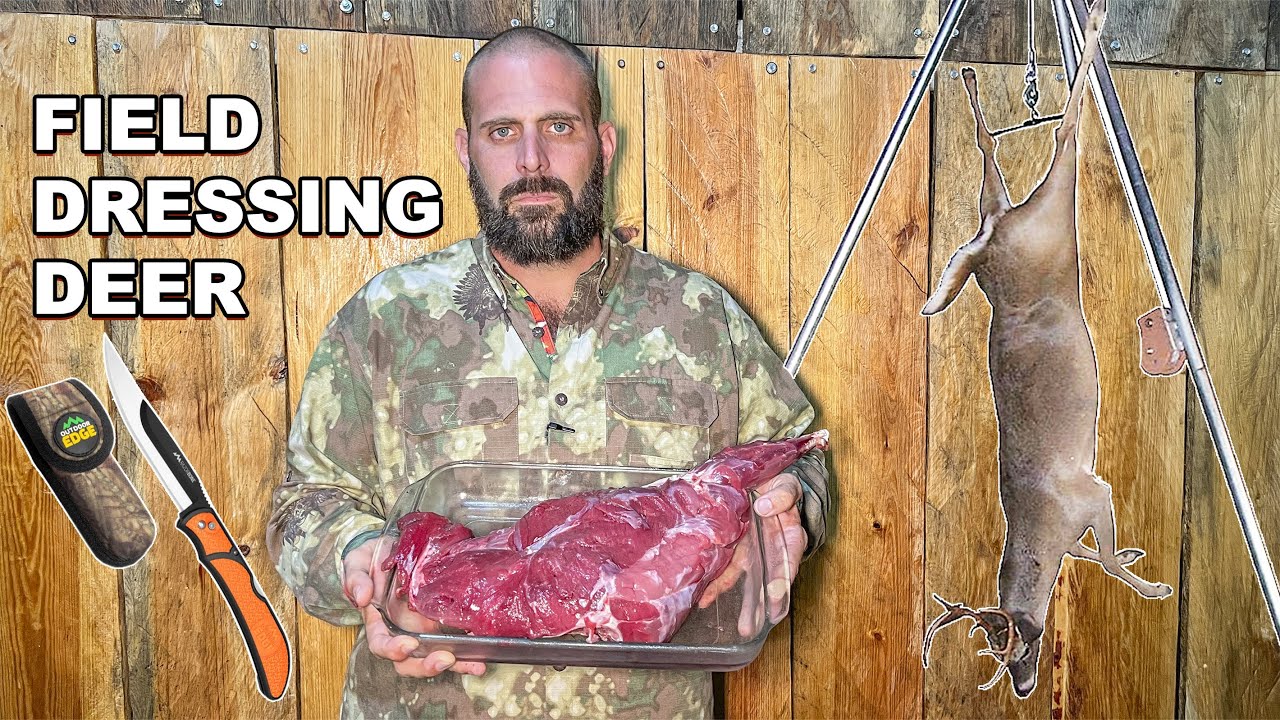Hey there, fellow hunting enthusiasts! If you've just tagged a buck, congratulations! But before you celebrate with friends and family, there's an important task ahead: field dressing. This process ensures your deer remains in top condition for processing and ultimately, for your delicious meals. In this blog post, we’ll cover essential tips and expert YouTube tutorials that illustrate the technique, so you can confidently tackle this job. Whether you’re a novice or seasoned hunter, mastering field dressing is a game-changer!
The Importance of Proper Field Dressing

Field dressing isn’t just a rite of passage for hunters; it plays a crucial role in ensuring the quality of the meat and maintaining hygiene. Let’s dive into why you absolutely should take this aspect of hunting seriously:
- Preserving Meat Quality:
When you field dress a deer correctly and promptly, you help eliminate heat buildup and bacteria, both of which can spoil the meat. The longer a deer sits after being harvested, the higher the risk of spoilage, especially in warmer temperatures.
- Reducing Contamination:
Improper handling can lead to contamination from gastrointestinal contents. When field dressing, it's vital to be careful not to puncture any organs during the process. A clean field dress ensures that no harmful bacteria from the gut infects the meat.
- Simplifying Transport:
Field dressing makes it much easier to transport your buck from the hunting site to your vehicle. An undressed deer is heavy and cumbersome, while a properly dressed one is significantly lighter and more manageable.
- Good Practice:
Developing the skill of field dressing instills a sense of responsibility and respect for your harvested animal. It’s a part of the hunting tradition that encourages hunters to honor their game.
Not only does field dressing properly emphasize high-quality game meat, but it also enhances the overall hunting experience. With tutorials available on YouTube, you can see the techniques demonstrated in real-time, which is an invaluable resource for both newbies eager to learn and veterans looking to refine their skills.
Be sure to check out some expert tutorials when you have a chance. They'll show you step-by-step how to field dress a buck, enabling you to hit the ground running when the time comes. Remember, practice makes perfect, and soon you’ll find yourself field dressing with the skill and confidence of a pro!
Also Read This: Who Is the Worst YouTuber – Examining Controversial YouTubers and Their Impact
3. Essential Tools and Equipment Needed
Before you head out for that much-anticipated hunting trip, it's crucial to make sure you have the right tools in your kit. Having the proper equipment can make all the difference in how easy and efficient your field dressing process will be. Here’s a quick list of essential tools you'll need:
- Drop Point Knife: A good quality drop point knife is essential for skinning and gutting. Look for one with a comfortable grip and a blade that's easy to sharpen.
- Bone Saw: Depending on how cleanly you want to process your buck, a bone saw can help you section the deer if necessary.
- Field Dressing Gloves: Protect yourself from bacteria and keep your hands clean. Disposable gloves work perfectly for this purpose.
- Game Bags: After dressing the deer, it’s best to keep the meat clean and protected. Game bags help keep soil and insects away from your harvest.
- Gut Hook Knife: This specialized knife makes opening the abdomen simpler without damaging internal organs.
- Knife Sharpener: A dull knife is dangerous and frustrating. Bring a good knife sharpener to keep your tools in top shape.
- Rope or Parachute Cord: Useful for hanging the deer for easier access while you work. It's also handy for securing your gear or using as a makeshift tourniquet if needed.
- First Aid Kit: Accidents can happen. Having a basic kit on hand is always a smart move, just in case.
- Flashlight or Headlamp: If you're dressing your buck at dusk or even in the dark, you'll need good lighting.
Having these tools ready can make the process smoother and more efficient. Not only will you make your job easier, but you'll also have a more satisfying hunting experience. Always check local regulations regarding field dressing to ensure compliance, and double-check that you have any necessary permits or tags with you!
Also Read This: Can I Watch Warriors Games on YouTube TV? A Guide to Watching Golden State Warriors Games
4. Step-by-Step Guide to Field Dressing a Buck
So, you’ve successfully brought down your buck—congratulations! Now it’s time to field dress it. While it might seem daunting at first, breaking it down into steps makes it manageable. Here’s a step-by-step guide to get you through the process:
- Preparation: Choose a clean area to work in. Lay the deer on its back and elevate it slightly if possible. Ensure you have all your tools on hand.
- Initial Cut: With your drop point knife, make a shallow cut below the breastbone, being careful not to puncture any organs. This is where you'll begin your incision, extending towards the groin.
- Open the Body Cavity: Using the gut hook or drop point knife, carefully extend the cut down to the pelvic area. Be mindful to avoid any cuts that could damage the intestines or bladder.
- Remove organs: Once you've opened the body cavity, you can start to remove the organs. Begin by cutting the diaphragm to access the lungs and heart. Pull gently to avoid tearing.
- Cutting Away the Anus: To prevent contamination, you’ll want to remove the anus. Slice around it, but don’t puncture it. Once you free it from the body, you can tie it off with string or cord.
- Remove the Head (Optional): If you plan on taking the head with you for mounting, now is the time to cut it off. Get a bone saw, and neatly sever the neck.
- Drain and Cool: Drain all fluids for about 15-20 minutes, ensuring proper cooling of the meat. If possible, hang the deer to facilitate this.
- Pack It Up: Use game bags to cover the meat and keep it safe during transport. Ensure everything is secure before heading out.
And there you have it! With practice, you'll become more confident and efficient in field dressing. Remember, every hunter develops their own technique over time, so don’t stress too much if it doesn’t go perfectly at first. Happy hunting!
Also Read This: How to Check Your YouTube Music Recap for the Year
5. Expert YouTube Tutorials: Top Channels to Follow
If you're diving into the world of field dressing a buck, having the right guidance is crucial for efficiency and success. YouTube is brimming with expert tutorials that can walk you through each step, from gutting to skinning to properly handling the meat. Here are some top channels you should definitely check out:
- MeatEater - This channel not only covers hunting techniques but also has clear, detailed videos on field dressing and processing game. Their hosts are knowledgeable and provide practical insights that can help you grasp the nuances of the process.
- Hunting Public - Known for their relatable hunts and practical advice, they also offer excellent tutorials on field dressing and caring for your game in the field.
- Field & Stream - With an extensive library of outdoor-related content, their field dressing tutorials are concise and focus on the essentials. You’ll appreciate their clear visuals and professional tips.
- Outdoor Life - This channel breaks down complex processes into easy-to-understand steps. Their commitment to quality content means you're in for some top-notch tutorials.
- ET Outdoors - If you’re looking for a contemporary twist on traditional hunting practices, check out ET Outdoors. Their videos are engaging and filled with useful tips that cater to both novices and seasoned hunters alike.
When exploring these channels, remember to engage with their communities. Comments sections can often reveal additional tips from fellow hunters and can help you troubleshoot any issues you might encounter while you learn. Plus, subscribing to these channels will keep you updated on their latest tips and techniques, making sure you're always learning something new about field dressing and hunting in general.
Also Read This: How to Charge Your Rose Without a Magnetic Charger on YouTube: A Simple Guide
6. Common Mistakes to Avoid When Field Dressing
Field dressing a buck is a skill that can make or break your hunting experience. Even seasoned hunters can fall prey to common pitfalls that could endanger the quality of the meat or disrupt the entire process. Here are several mistakes to steer clear of:
- Not Using the Right Tools: One of the biggest mistakes is not having the proper tools on hand. A sharp knife, gloves, and a field dressing kit are essential. Investing in quality tools can save you time and ensure a cleaner process.
- Rushing the Process: Field dressing isn’t a task to rush through. Taking your time not only ensures you do it properly but helps you avoid making mistakes that could spoil the meat. Take a deep breath and focus on each step.
- Improperly Handling the Organs: When it comes to field dressing, careful handling of the internal organs is vital. Accidentally puncturing the intestines or bladder can contaminate the meat, leading to unpalatable flavors.
- Ignoring Hygiene: Always wash your hands before and after the process. Using gloves is also a good idea. You want to keep everything as clean as possible to maintain the quality of the meat.
- Failing to Drain the Blood: Blood can spoil quickly, affecting the flavor and texture of the meat. Make sure to drain it out thoroughly to maintain freshness.
By being aware of these common mistakes, you can avoid them and enhance your field dressing skills. Remember, practice makes perfect. The more you do it, the better you’ll become at spotting potential issues and executing the process smoothly. Happy hunting!
Also Read This: Stripping Audio from YouTube Videos for Personal Use
7. Post-Dressing Care and Handling of the Meat
Once you’ve successfully field dressed your buck, the work isn’t quite finished. Proper care and handling of the meat are essential to ensure that it’s safe to eat and stays flavorful. Here are some key steps to consider:
- Cool Down the Meat: As soon as the field dressing is complete, it’s vital to cool the meat quickly. High temperatures can lead to spoilage. If possible, hang the deer in a shaded area or place it in a cooler with ice packs to bring down the temperature.
- Avoid Contamination: Make sure to handle the meat with clean gloves. Avoid contact with dirt, hair, or anything that could contaminate it. Use clean knives and equipment to minimize the risk of bacteria.
- Skinning: If you haven’t skinned the deer yet, do it promptly. The hide can trap heat and moisture, which leads to quicker spoilage. Follow the proper skinning techniques to minimize hair or contamination coming into contact with the meat.
- Quartering: You may want to quarter the deer for easier transport and cooling. Use a sharp knife to ensure clean cuts. Remember to remove the organs carefully and avoid puncturing the intestines or bladder to prevent tainting the meat.
Once the deer is quartered, store the meat in a cooler or refrigerator that maintains a temperature of around 34-36°F. If you’re away from home, a portable cooler with ice is essential. Check regularly to ensure ice is still intact, and consider draining excess water to keep the meat dry.
Another factor to consider is aging the meat. Aging can enhance the flavor and tenderness. If you choose to age the meat, hang the quarters in a cool, dry place with good ventilation for a few days, usually between 3 to 14 days, depending on conditions and personal preference.
Lastly, make sure to package the meat properly if you plan to freeze it. Use airtight bags or vacuum sealers to prevent freezer burn. Label your packages with the date and type of cut for easy identification later.
8. Conclusion and Final Tips for Success
Field dressing a buck can seem intimidating at first, but with practice and the right techniques, it becomes a manageable and even rewarding task. Remember, the key is preparation and a calm approach. Here are some final tips to help you succeed:
- Practice Makes Perfect: Don’t shy away from practicing your skills. If you have access to roadkill or other deer, practicing field dressing can help solidify your techniques.
- Stay Educated: Keep watching expert YouTube tutorials and read articles to improve your knowledge. There’s always something new to learn!
- Use the Right Tools: Invest in quality knives and tools that you’re comfortable using. A good field dressing kit can make the entire process easier and more efficient.
- Stay Patient: Rushing through the process can lead to mistakes. Take your time to ensure everything is done correctly, especially if you’re new to the process.
- Cherish the Experience: Field dressing is not just about the meat; it’s part of a larger tradition. Enjoy the experience, connect with nature, and share your stories with fellow hunters.
In conclusion, field dressing a buck is a skill worth developing. Following these steps will not only help you handle the deer properly but also ensure you enjoy the fruits of your labor. Happy hunting, and may your future outings be successful!
 admin
admin








